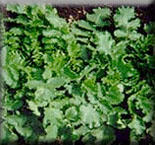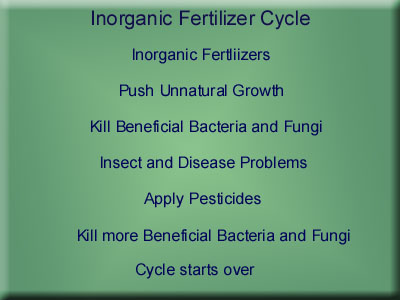|
|
Getting to the Root of your Problems | ||||
Solutions for |
|
|
|
|
|
|
|
|
|
|
|
|
| Home |
| Purchase Products |
| Products |
| FAQ's |
| Articles |
| More Articles |
| Photo Gallery |
| Research |
| Contact Us |
| Plant Grow System - 4 Steps to Healthier Plants |
 |
||

- N, P, K Program Results after 2 weeks |
Making The Transition | 
Organic Program - Results after 2 weeks |
What is the fundamental difference between traditional N, P, K Programs and Organic Programs? In traditional N, P, K programs the primary function of the soil is to hold the plant upright so the applicator can inundate the plant with chemical fertilizers and pesticides, thereby perpetuating a vicious cycle! In organic programs you feed the soil first the plant second! Your goal is to create the ideal soil environment, one that is biologically active, for the particular plant type you are growing / maintaining. What is the vicious cycle? When you apply inorganic fertilizers you push excessive, unnatural growth. This excessive growth actually brings on insect and disease problems. It is then necessary to apply pesticides (insecticides & fungicides) to bring these manifestations under control. Furthermore the pesticides and inorganic fertilizers negatively impact the beneficial microbial populations in the soil, which naturally protect plants from disease and promote healthy sustained growth. How do you break the cycle? The first step to breaking the cycle is to re-establish the biological activity in the soil, or to bioremediate the soil. This is accomplished by introducing beneficial bacteria, actinomycetes and fungi into the soil. They will protect the plant from pathogenic microorganisms (soil & foliar), minimize nutrient leaching, aid in nutrient cycling and absorption, improve soil structure, solubilize minerals (including phosphorous) for plant availability, produce natural plant growth hormones, enhance plant growth, increase soil buffering properties and reduce the negative effects of environmental stress. . THAT IS WHERE YOU START! If I have insect problems what can I use other than synthetic chemical insecticides? There are a number of environmentally friendly alternatives to safely control insect populations. (soaps, oils, beneficial insects, BT, milky spore, beneficial nematodes) Both K-Neem and Organocide are highly effective in effectively managing a wide range of pests. Doesn't it take years for organic programs to work? No. That is a misconception that has been perpetuated by the chemical industry it is simply not true. The switch can be successfully achieved in one growing season or less. It is true that there is a transition period when your chemically dependant plants go through withdrawal, the secret again is to get enough beneficial bacteria, actinomycetes & fungi into the soil and on the foliage to compensate for the removal of pesticides! While initially an organic program might appear to cost a little more to implement, in the end it is cheaper. Standard cultural practices (inorganic fertilizers & pesticides) are counter productive (Law of Diminishing Returns).
|
||
|
|||||||||||||||
| Copyright ©2002 ArborGrow.com All Rights Reserved |
